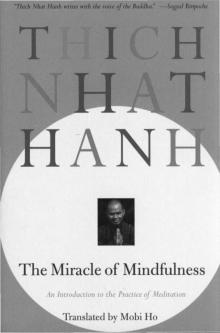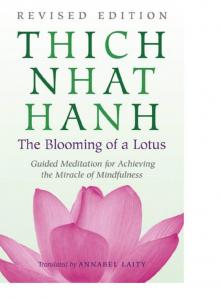- Home
- Thich Nhat Hanh
The Miracle of Mindfulness (Gift Edition) Page 9
The Miracle of Mindfulness (Gift Edition) Read online
Page 9
4. The Seven Factors of Enlightenment
And further, monks, a monk lives contemplating mental objects in the mental objects of the seven factors of enlightenment.
How, monks, does a monk live contemplating mental objects in the mental objects of the seven factors of enlightenment?
Herein, monks, when the enlightenment-factor of mindfulness is present the monk knows, “The enlightenment-factor of mindfulness is in me,” or when the enlightenment-factor of mindfulness is absent, he knows, “The enlightenment-factor of mindfulness is not in me”; and he knows how the arising of the nonarisen enlightenment-factor of mindfulness comes to be; and how perfection in the development of the arisen enlightenment-factor of mindfulness comes to be.
When the enlightenment-factor of the investigation of mental objects is present, the monk knows, “The enlightenment-factor of the investigation of mental objects is in me”; when the enlightenment-factor of the investigation of mental objects is absent, he knows, “The enlightenment-factor of the investigation of mental objects is not in me”; and he knows how the arising of the nonarisen enlightenment-factor of the investigation of mental objects comes to be, and how perfection in the development of the arisen enlightenment-factor of the investigation of mental objects comes to be.
When the enlightenment-factor of energy is present, he knows, “The enlightenment-factor of energy is in me”; when the enlightenment-factor of energy is absent, he knows, “The enlightenment-factor of energy is not in me”; and he knows how the arising of the nonarisen enlightenment-factor of energy comes to be, and how perfection in the development of the arisen enlightenment-factor of energy comes to be.
When the enlightenment-factor of joy is present, he knows, “The enlightenment-factor of joy is in me”; and when the enlightenment-factor of joy is absent, he knows, “The enlightenment-factor of joy is not in me”; and he knows how the arising of the nonarisen enlightenment-factor of joy comes to be, and how perfection in the development of the arisen enlightenment-factor of joy comes to be.
When the enlightenment-factor of tranquility is present, he knows, “The enlightenment-factor of tranquility is in me”; when the enlightenment-factor of tranquility is absent, he knows, “The enlightenment-factor of tranquility is not in me”; and he knows how the arising of the nonarisen enlightenment-factor of tranquility comes to be, and how perfection in the development of the arisen enlightenment-factor of tranquility comes to be.
When the enlightenment-factor of concentration is present, he knows, “The enlightenment-factor of concentration is in me”; when the enlightenment-factor of concentration is absent, he knows, “The enlightenment-factor of concentration is not in me”; and he knows how the arising of the nonarisen enlightenment-factor of concentration comes to be, and how perfection in the development of the arisen enlightenment-factor of concentration comes to be.
When the enlightenment-factor of equanimity is present, he knows, “The enlightenment-factor of equanimity is in me”; when the enlightenment-factor of equanimity is absent, he knows, “The enlightenment-factor of equanimity is not in me”; and he knows how the arising of the nonarisen enlightenment-factor of equanimity comes to be, and how perfection in the development of the arisen enlightenment-factor of equanimity comes to be.
Thus he lives contemplating mental objects in mental objects internally, or he lives contemplating mental objects in mental objects externally, or he lives contemplating mental objects in mental objects internally and externally. He lives contemplating origination-factors in mental objects, or he lives contemplating dissolution-factors in mental objects, or he lives contemplating origination-and-dissolution-factors in mental objects. Or his mindfulness is established with the thought, “Mental objects exist,” to the extent necessary just for knowledge and mindfulness, and he lives detached, and clings to naught in the world. Thus, monks, a monk lives contemplating mental objects in mental objects of the seven factors of enlightenment.
5. The Four Noble Truths
And further, monks, a monk lives contemplating mental objects in the mental objects of the four noble truths.
How monks, does a monk live contemplating mental objects in the mental objects of the four noble truths?
Herein, monks, a monk knows, “This is suffering,” according to reality; he knows, “This is the origin of suffering,” according to reality; he knows “This is the cessation of suffering,” according to reality; he knows, “This is the road leading to the cessation of suffering,” according to reality.
Thus he lives contemplating mental objects in mental objects internally, or he lives contemplating mental objects in mental objects externally, or he lives contemplating mental objects in mental objects internally and externally. He lives contemplating origination-factors in mental objects, or he lives contemplating dissolution-factors in mental objects, or he lives contemplating origination-and-dissolution-factors in mental objects. Or his mindfulness is established with the thought, “Mental objects exist,” to the extent necessary just for knowledge and mindfulness, and he lives detached, and clings to naught in the world. Thus, monks, a monk lives contemplating mental objects in the mental objects of the four noble truths.
Verily, monks, whosoever practices these four Foundations of Mindfulness in this manner for seven years, then one of these two fruits may be expected by him: Highest Knowledge (Arahatship), here and now, or if some remainder of clinging is yet present, the state of Nonreturning.
O monks, let alone seven years. Should any person practicing these four Foundations of Mindfulness in this manner for six years . . . for five years . . . three years . . . two years . . . one year, then one of these two fruits may be expected by him: Highest Knowledge, here and now, or if some remainder of clinging is yet present, the state of Nonreturning.
O monks, let alone a year. Should any person practice these four Foundations on Mindfulness in this manner for seven months . . . for six months . . . five months . . . four months . . . three months . . . two months . . . a month . . . half a month, then one of these two fruits may be expected by him: Highest Knowledge, here and now, or if some remainder of clinging is yet present, the state of Nonreturning.
O monks, let alone half a month. Should any person practice these four Foundations of Mindfulness in this manner, for a week, then one of these two fruits may be expected by him: Highest Knowledge, here and now, or if some remainder of clinging is yet present, the state of Nonreturning.
Because of this it is said: “This is the only way, monks, for the purification of beings, for the overcoming of sorrow and lamentation, for the destruction of suffering and grief, for reaching the right path, for the attainment of Nirvana, namely the four Foundations of Mindfulness.”
Thus spoke the Blessed One. Satisfied, the monks approved of his words.
THE DISCOURSE ON MINDFULNESS OF BREATHING
(Anāpānasati Sutta)
Translated from the Pali by Nyānaponika
Mindfulness of Breathing, monks, cultivated and regularly practiced, is of great fruit and great benefit. Mindfulness of Breathing, cultivated and regularly practiced, brings to Perfection the four Foundations of Mindfulness. The four Foundations of Mindfulness, cultivated and regularly practiced, bring the seven Factors of Enlightenment to perfection; the seven Factors of Enlightenment, cultivated and regularly practiced, bring wisdom and deliverance to perfection.
And how cultivated and regularly practiced, is Mindfulness of Breathing of great fruit and benefit?
Herein, monks, a monk having gone to the forest, to the foot of a tree, or to an empty place, sits down cross-legged, keeps his body erect and his mindfulness alert. Just mindful he breathes in, mindful he breathes out.
I. THE FIRST TETRAD (CONTEMPLATION OF THE BODY)
1. Breathing in a long breath, he knows, “I breathe in a long breath”; breathing out a long breath, he knows, “I breathe out a long breath.”
2. Breathing in a short breath, he knows, “I breathe in a short breath�
��; breathing out a short breath, he knows, “I breathe out a short breath.”
3. “Experiencing the whole body I shall breathe in,” thus he trains himself; “Experiencing the whole body I shall breathe out,” thus he trains himself.
4. “Calming the bodily function (of breathing) I shall breathe in,” thus he trains himself; “Calming the bodily function (of breathing) I shall breathe out,” thus he trains himself.
II. THE SECOND TETRAD (CONTEMPLATION OF FEELINGS)
5. “Experiencing rapture I shall breathe in (I shall breathe out),” thus he trains himself.
6. “Experiencing happiness I shall breathe in (I shall breathe out),” thus he trains himself.
7. “Experiencing the mental functions I shall breathe in (I shall breathe out),” thus he trains himself.
8. “Calming the mental functions I shall breathe in (I shall breathe out),” thus he trains himself.
III. THE THIRD TETRAD (CONTEMPLATION OF THE MIND)
9. “Experiencing the mind I shall breathe in (I shall breathe out),” thus he trains himself.
10. “Gladdening the mind I shall breathe in (I shall breathe out),” thus he trains himself.
11. “Concentrating the mind, I shall breathe in (I shall breathe out),” thus he trains himself.
12. “Liberating the mind I shall breathe in (I shall breathe out),” thus he trains himself.
IV. THE FOURTH TETRAD (CONTEMPLATION OF MIND-OBJECTS)
13. “Contemplating impermanence I shall breathe in (I shall breathe out),” thus he trains himself.
14. “Contemplating dispassion I shall breathe in (I shall breathe out),” thus he trains himself.
15. “Contemplating cessation I shall breathe in (I shall breathe out),” thus he trains himself.
16. “Contemplating relinquishment I shall breathe in (I shall breathe out),” thus he trains himself.
17. In that way, cultivated and regularly practiced, monks, Mindfulness of Breathing brings great fruit and benefit.
PERFECTING THE FOUNDATIONS OF MINDFULNESS
And how cultivated, how regularly practiced brings Mindfulness of Breathing the four Foundations of Mindfulness to perfection?
I. Whenever a monk mindfully breathes in and out a long breath, or a short breath; or when he trains himself to breathe in and out while experiencing the bodily function (of breathing); or while calming that function—at that time, monks, he dwells practicing body-contemplation on the body, ardent, clearly comprehending, and mindful; having overcome covetousness and grief concerning the world. For, breathing in and out, monks, I say, is one of the bodily processes.
II. Whenever the monk trains himself to breathe in and out while experiencing rapture; or while experiencing happiness; or while experiencing the mental functions; or while calming the mental functions—at those times, monks, he dwells practicing feeling-contemplation on feelings, ardent, clearly comprehending, and mindful, having overcome covetousness and grief concerning the world. For the full attention to breathing in and out, I say, is one of the feelings.
III. Whenever a monk trains himself to breathe in and out while experiencing the mind; or while gladdening the mind; or while concentrating the mind; or while liberating the mind—at that time he dwells practicing mind-contemplation on the mind, ardent, clearly comprehending, and mindful, having overcome covetousness and grief concerning the world. For one who lacks mindfulness and clear comprehension, I say, cannot develop Mindfulness of Breathing.
IV. Whenever a monk trains himself to breathe in and out while contemplating impermanence, dispassion, cessation, or relinquishment—at that time he dwells practicing mind-object contemplation on mind-objects, ardent, clearly comprehending, and mindful, having overcome covetousness and grief concerning the world. Having wisely seen the abandoning of covetousness and grief, he looks on with perfect equanimity.
Mindfulness of Breathing, monks, in that way cultivated and regularly practiced, brings the four Foundations of Mindfulness to perfection.
And how do the four Foundations cultivated and regularly practiced, bring the seven Factors of Enlightenment to perfection?
Whenever a monk dwells in the contemplation of body, feelings, mind, and mind-objects, ardent . . . unclouded mindfulness becomes established in him. And when unclouded mindfulness is established in him, at that time the enlightenment-factor “Mindfulness” is initiated in the monk; at that time the monk develops the enlightenment-factor Mindfulness; at that time he gains perfection in the development of the enlightenment-factor “Mindfulness.”
Dwelling mindful in that manner, he wisely investigates, examines, and scrutinizes the respective object; and while doing so, the enlightenment-factor “Investigation of Reality” is initiated in the monk; at that time the monk develops the enlightenment-factor “Investigation of Reality”; at that time he gains perfection in the development of the enlightenment-factor “Investigation of Reality.”
While he wisely investigates, examines, and scrutinizes that object, unremitting energy is initiated in him. And when the unremitting factor “Energy” is initiated in him, at that time the monk develops the enlightenment-factor “Energy”; at that time he gains perfection in the development of the enlightenment-factor “Energy.”
In him possessed of energy unworldly rapture arises. And when in a monk possessed of energy unworldly rapture arises, at that time the enlightenment-factor “Rapture” is initiated in him; at that time the monk develops the enlightenment-factor “Rapture”; at that time the monk gains perfection in the development of the enlightenment-factor “Rapture.”
The body and mind of one who is filled with rapture become tranquil. And when the body and mind of one who is filled with rapture become tranquil, at that time the enlightenment-factor “Tranquility” is initiated in him; at that time the monk develops the enlightenment-factor “Tranquility.”
The mind of one who is tranquil and happy becomes concentrated. And when the mind of a monk who is tranquil and happy becomes concentrated, at that time the enlightenment-factor “Concentration” is initiated in him; at that time the monk develops the enlightenment-factor “Concentration”; at that time he gains perfection in the development of the enlightenment-factor “Concentration.”
On the mind thus concentrated he looks with perfect equanimity. And when looking on his concentrated mind with perfect equanimity, at that time the enlightenment factor “Equanimity” is initiated in him; at that time the monk develops the enlightenment-factor “Equanimity”; at that time he gains perfection in the development of the enlightenment-factor “Equanimity.”
The four Foundations of Mindfulness, in that way cultivated and regularly practiced, bring the seven Factors of Enlightenment to perfection.
And how do the seven Factors of Enlightenment, cultivated and regularly practiced, bring wisdom and deliverance to perfection?
Herein, monks, a monk develops the enlightenment-factors Mindfulness, Investigation of Reality, Energy, Rapture, Tranquility, Concentration, and Equanimity, based on detachment, based on dispassion, based on cessation, resulting in relinquishment.
The seven Factors of Enlightenment, in that way cultivated and regularly practiced, bring wisdom and deliverance to perfection.
Thus spoke the Exalted One. Glad in heart the monks rejoiced in the words of the Blessed One.
CONTEMPLATION OF THOUGHT
(From Siksāsamuccaya)
Translated from the Sanskrit by Edward Conze
He searches all around for his thought. But what thought? It is either passionate, or hateful, or confused. What about the past, future, or present? What is past that is extinct, what is future that has not yet arrived, and the present has no stability. For thought, Kasyapa, cannot be apprehended, inside, or outside, or in between both. For thought is immaterial, invisible, nonresisting, inconceivable, unsupported, and homeless. Thought has never been seen by any of the Buddhas, nor do they see it, nor will they see it. And what the Buddhas never see, how can that be an observable
process, except in the sense that dharmas proceed by the way of mistaken perception? Thought is like a magical illusion; by an imagination of what is actually unreal it takes hold of a manifold variety of rebirths. A thought is like the stream of a river, without any staying power; as soon as it is produced it breaks up and disappears. A thought is like the flame of a lamp, and it proceeds through causes and conditions. A thought is like lightning, it breaks up in a moment and does not stay on. . . .
Searching for thought all round, he does not see it within or without. He does not see it in the skandhas, or in the elements, or in the sense-fields. Unable to see thought, he seeks to find the trend of thought, and asks himself: Whence is the genesis of thought? And it occurs to him that “where there is an object, there thought arises.” Is then the thought one thing, and the object another? No, what is the object, just that is the thought. If the object were one thing, and the thought another, then there would be a double state of thought. So the object itself is just thought. Can then thought review thought? No, thought cannot review thought. As the blade of a sword cannot cut itself, so a thought cannot see itself. Moreover, vexed and pressed hard on all sides, thought proceeds, without any staying power, like a monkey or like the wind. It ranges far, bodiless, easily changing, agitated by the objects of sense, with the six sense-fields for its sphere, connected with one thing after another. The stability of thought, its one-pointedness, its immobility, its undistraughtness, its one-pointed calm, its nondistraction, that is on the other hand called mindfulness as to thought.

 How to Love
How to Love The Miracle of Mindfulness
The Miracle of Mindfulness The Miracle of Mindfulness (Gift Edition)
The Miracle of Mindfulness (Gift Edition) The Blooming of a Lotus
The Blooming of a Lotus The Novice
The Novice